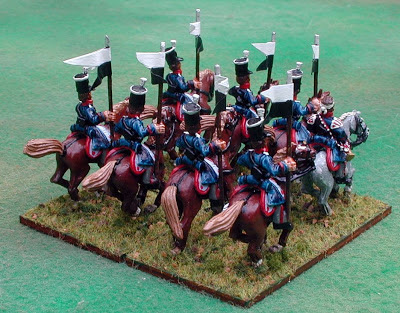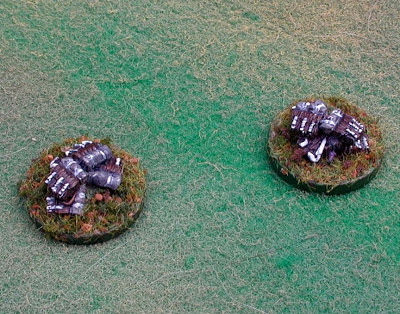The formation of the Prussian Landwehr Cavalry was decreed in March, 1813. At more or less the same time, many of the Prussian provinces also raised a National Cavalry Regiment; these last were ultimately taken into the line Cavalry in 1815. These national Cavalry regiments included the Prussian, Pomeranian, Silesian, and Elbe National Kavallerie Regiments. Each of the National regiments had its own unique uniform and coloration. The uniforms of the National Cavalry Regiments is well covered in David Nash's The Prussian Army, 18098-1813 by Almark Publications (London, September 1972); the text and line drawing are reproduced verbatim here.
It is stated that during the autumn campaign in 181 there were 113 squadrons of Landwehr Cavalry in 30 regiments (squadrons typically having only 72 - 100 men each), numbering 10.952 men, while the Line and National Cavalry regiments combined had 89 squadrons with a total of 13.375 men. According to Peter Hofshroer's Osprey (Prussian Cavalry of the Napoleonic Wars (2): 1807-15), there were another 22 depot or replacement squadrons totaling 3,389 men, and another 23 squadrons of Volunteers and Foreign cavalry totaling an additional 3,064 men . By 1815, the Prussian Landwehr Cavalry stood as follows:
The regulation dress for the Landwehr Cavalry was a dark blue coat, with the collar and the piping on the cuffs in the Provincial colors as above. The Litewka wa a long rather plain coat without tails or turnbacks. All leather work was black, and the trouser were generally grey, with or without piping on the outside seam, either in red (like the Regular cavalry wore) or the provincial color. A sword and lance (with pennons in the provincial patterns listed above) were carried. The regulation head dress was a black cavalry shako with a white Landwehr cross, worn uncovered (although it was often worn covered ). The shoulder straps were colored according to the seniority of the regiment within the province (some say bu the squadron, and Hofschroer states that the regimental number was embroidered on the strap in yellow (red on yellow straps). One strongly suspects the embroidery was observed largely in the breach! In either case, the straps were 1st - white, 2nd - red, 3rd - yellow, and 4th - light blue The saddle blankets were usually black sheepskin with scalloped edging in the Provincial color.
Although it has been estimated that about 75% of the Landwehr cavalry wore uniforms essentially as above, there were of course numerous exceptions. These are well described in David Nash's book cited previously, and the relevant sections reproduced at the link above. The two units that I did both have non regulation uniforms (of course!). In part, that's because the two catalog numbers of Old Glory 25mm figures offered specifically as Landwehr cavalry wear such (Prussian Line Dragoon castings would actually work fine as Landwehr cavalry wearing covered shakos and with their swords out).
It is stated that during the autumn campaign in 181 there were 113 squadrons of Landwehr Cavalry in 30 regiments (squadrons typically having only 72 - 100 men each), numbering 10.952 men, while the Line and National Cavalry regiments combined had 89 squadrons with a total of 13.375 men. According to Peter Hofshroer's Osprey (Prussian Cavalry of the Napoleonic Wars (2): 1807-15), there were another 22 depot or replacement squadrons totaling 3,389 men, and another 23 squadrons of Volunteers and Foreign cavalry totaling an additional 3,064 men . By 1815, the Prussian Landwehr Cavalry stood as follows:
Province
|
# of Rgts
|
Collar/Cuffs
|
Buttons
|
Lance Pennons
|
East Prussia
|
5
|
Poppy Red
|
White
|
red/white
|
Kurmark/Neumark
|
2/7
|
Poppy Red
|
Yellow
|
white/black
|
West Prussia
|
3
|
Black *
|
White
|
yellow/crimson
|
Pomerania
|
2
|
White
|
Yellow
|
white/black
|
Silesia
|
8
|
Yellow
|
White
|
white/yellow
|
Westphalia
|
1
|
Green
|
White
|
orange?
|
Elbe
|
1
|
Light Blue
|
Yellow
|
blue/red
|
Rhineland
|
0/3 #
|
Madder Red
|
Yellow
|
white/crimson
|
* Brick Red (Orange-Red) was usually substituted for black (presumably because black didn't show well on the dark blue coats, and the Landwehr infantry from West Prussia used this color.
# 3 Regiments, but all were raised after November 1815
The regulation dress for the Landwehr Cavalry was a dark blue coat, with the collar and the piping on the cuffs in the Provincial colors as above. The Litewka wa a long rather plain coat without tails or turnbacks. All leather work was black, and the trouser were generally grey, with or without piping on the outside seam, either in red (like the Regular cavalry wore) or the provincial color. A sword and lance (with pennons in the provincial patterns listed above) were carried. The regulation head dress was a black cavalry shako with a white Landwehr cross, worn uncovered (although it was often worn covered ). The shoulder straps were colored according to the seniority of the regiment within the province (some say bu the squadron, and Hofschroer states that the regimental number was embroidered on the strap in yellow (red on yellow straps). One strongly suspects the embroidery was observed largely in the breach! In either case, the straps were 1st - white, 2nd - red, 3rd - yellow, and 4th - light blue The saddle blankets were usually black sheepskin with scalloped edging in the Provincial color.
Although it has been estimated that about 75% of the Landwehr cavalry wore uniforms essentially as above, there were of course numerous exceptions. These are well described in David Nash's book cited previously, and the relevant sections reproduced at the link above. The two units that I did both have non regulation uniforms (of course!). In part, that's because the two catalog numbers of Old Glory 25mm figures offered specifically as Landwehr cavalry wear such (Prussian Line Dragoon castings would actually work fine as Landwehr cavalry wearing covered shakos and with their swords out).
This unit is the 4th Silesian Landwehr Cavalry. They wear the Schirmutz cap instead of the shako. This might have a white Landwehr cross upon it (same for the shako).
The Litewka jacket has the collar and the piping on the cuffs in yellow, the Provincial color for Silesia. The light blue shoulder straps indicate the 4th regiment. The trumpeter has yellow shoulder wings with white lace, and the trumpet cords are yellow mixed with white; he rides a grey horse as was often the case for the line.
The Silesian units were known to often use white sheepskin saddles instead of black, and often had white overcoats; the white overcoat is sen rolled up here. The lance pennons are the specified white over yellow for Silesia. These pictures were taken outside on an overcast day - the natural, diffused light made the pictures come out better than my usual, I think!
This unit is the 1st Neumark Landwehr Cavalry. Equipped by the British. this unit has a tall. "stovepipe" type shako with a large black within white Prussian cockade on the front, and white trim on the top. White cords could also be worn on the shako.
The unit's saddle blanks are also unusual in being colored light blue-grey, with red heart ornaments in the corners (which should be pointed, unusually for Prussian cavalry of this era (although they are rounded on these figures). The 2nd regiment also shared these features. White over black lance pennons are carried as per the Provincial distinctions listed above. This could also bear a Landwehr cross emblem upon it
The white shoulder straps mark this as the 1st Regiment. The trumpeter once again rides a grey horse. Grey overalls with a red stripe down the outside seam completes a rather attractive uniform, especially for Militia!
As each bag of Old Glory Cavalry has 10 figures there were some left over figures. The officers I painted to represent Colonels acting Brigade (Division) commanders. Each bag also had a mounted casualty figure. From this ankle, the trooper in white appears to be holding his nose as if to say "Phew! Those French stink of Garlic and who knows what else; I can smell them coming even from here!
In this shot the Officer in the foreground looks suitably professional, while the figure in the background appears to demonstrating the international signal for "I am Choking to Death!" Perhaps he needs the Heinrich.... er, Heimlich maneuver?!
In this final view, the situation of our unfortunate Prussian seems rather more dire!
Well, the sculptor must have been very proud of this fellow, because here he is *again* in the other bag!
The officer in Schirmutze cap will work fine as an infantry or cavalry leader.
A final view of the dubious duo. The flock is Scenic Express "Alpine Meadow Blend". I eally like the mixture of foam flock, static grass, and "rocks" in this blend.
.
Finally, a couple of markers for in game use - stacks of back packs.
Some web links for more information:
Doubtless the best source for these units would be Dr Stephen Summerfield's "Prussian Napoleonic Landwehr Infantry and Cavalry 1813-1815: Landsturm, Volunteer Cavalry and Styreifcvorps. At 380+ pages, including color illustrations. I may acquire it some day. The roughly $60 price, although hardly unreasonable for a very specialized topic, lots of research, and new artwork, has inhibited me thus far, however!
Mit Gott für König und Vaterland!
Peter













Really nice Peter,
ReplyDeleteVery animated figures with loads of character!
Cheers
Paul
Thanks, Paul. The animation of the OG figures, their favorable pricing (at least here in the US), and the breadth of their ranges are among the many strong points of Old Glory.
DeleteGreat info and figures I sort of like the 'choker' :-)
ReplyDeleteThanks, Garry. If I keep getting them in the cavalry packs I will have enough for an entire unit of them! :-)
DeleteGreat looking pictures! I do like the Prussian cavalry, and the wounded man...nice reading!
ReplyDeletePhil.
Thanks, Phil. I took advantage of the perfect lighting to take pictures of the rest of my Prussian Cavalry, so they will make their way here gradually over time as well.
DeleteGreat post, nice to have the pennant info in one easy to find place. I too like OG for the same reasons. The wounded officer is a great idea. Looking forward to the rest of your Prussian cavalry.
ReplyDeleteThanks, Mike. The rest of the Prussian horsemen will be forthcoming gradually as time permits!
Delete